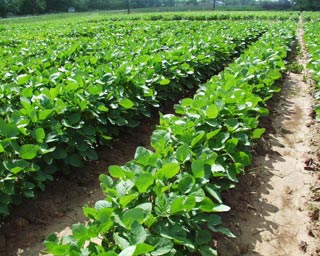Take care of winter soybeans
By this time, the soybean plant has been under 1 month (depending on the locality, depending on the variety .), is now entering the stage of preparation for flowering, so we only mention some points Main techniques in care, pest control and harvest for relatives to refer and apply.

Soybean fields (Photo: tamu)
With Northern provinces, soybean can grow 2 main crops for high efficiency: Spring-summer and winter crop so people can refer to the materials on seed, cultivation, care and pest control. diseases, etc., are regularly published in the Vietnam Agriculture Newspaper and local newspapers before entering the service or through the Agriculture Department, District Extension Station, Department of Agriculture, Extension Center and Plant Protection Sub-Departments. province to be provided with additional materials and technical advice. Due to the limited article, we introduced some experiences of Ha Tay people in recent years through documents of Ha Tay Agricultural Extension Center and Vietnam Institute of Agricultural Genetics:
Care : Because of the spillage, the tree grows unevenly, the farmers pluck up the thick growing areas to replant the sparse places to ensure density (45-55 plants / m2 with medium-day varieties, 55-65 plants / m 2 with short-term varieties) will yield the highest yield. The work of transplanting again must be completed 15 days after sowing. After finishing cutting, cover the root and water enough. Regularly conduct irrigation water to make enough moisture for the beans to grow and develop well, especially in flowering and raising big fruits. Pay attention to clearing the ditches to escape quickly after heavy rain, not to flood the fields.
The amount of fertilizer calculated for 1 North pole includes: 200kg of manure, 3kg of urea, 10kg of phosphate, 3kg of potassium fertilizer. Manure soaked into the hole in the corner of the field to mix with the chemical fertilizer. Apply first time when the bean has 1 real leaf (the first leaf above 2 cotyledons) by mixing 5kg of phosphate + 1.5kg of nitrogen + water of manure to mix with water to root. The second time when the beans have 3-4 leaves: Mix 5kg of phosphate + 1.5kg of nitrogen + 1.5kg of potassium + water of manure to mix well for irrigation. 3 times to stop when the beans have 5-6 leaves: Mix the remaining 1.5kg of potassium + water for manure to mix well for irrigation. Attention should be paid to finishing fertilizer 23 days after growing, not applying too late, affecting flowering, fruiting and grain quality later.
Pest and disease control : The winter crop has less pests and diseases than the summer-spring crop, however, it is necessary to pay attention to detect and prevent some of the following subjects: After sowing for 9 days (5 days after planting), Dipterex phase 2 / 1,000 plus with 1/1000 of 95SP Padan (10 liter pump bottle mixed with 2g Dipterex + 1g Padan) to spray thoroughly to prevent stem borers. After 3-5 days of spraying for the second time (plants with 7-8 true leaves) to eliminate leaf worms, can combine spraying with fertilizer products through leaves to increase grain yield. Fruit borer with Ofatox, Regent . concentration of 2 / 1,000. Use Zineb, Tilsupper to prevent rust, downy mildew and brown spots. Use Validamicin to treat root sores when plants are young. Also pay attention to eradicate pest damage, damage the flowers by catching by hand or placing traps Pheromone, sweet and sour traps mixed with insecticides and rats at the end of the season.
Harvest : When the leaves are yellow, some fall to the root, dried fruits are harvested. If the leaves are old and green leaves are abundant, you can spray salt water, spray ethrel or flush water to soak your feet 2-3 days and then drain the leaves to make it easy to harvest. Choose a sunny day to cut close to the root, dry it in the field, then transport it to dry in hot water. It is also possible to use a rice thresher to remove seeds, dry them (water level is about 13%), and clean fans to preserve in a cool or dry place.
- Soybeans - Precious remedy
- The reason why soy is considered a precious food is preventive
- Successfully decode the genome of soybeans
- Soybeans and cinnamon
- Soybeans cure infertility
- Eye care tips for office workers in the winter
- 10 principles for not getting sick in the winter
- 12 great things that soybeans bring to your health
- Do not take a lot of bathing in the winter to avoid itching
- Soybeans should be stopped before pregnancy
- Soybeans have the ability to help lose weight
- Hanoi winter moments
 'Barefoot engineer' invents a pipeless pump
'Barefoot engineer' invents a pipeless pump Process of handling dead pigs due to disease
Process of handling dead pigs due to disease Radiometer
Radiometer Warp Engine: Technology brings us closer to the speed of light
Warp Engine: Technology brings us closer to the speed of light